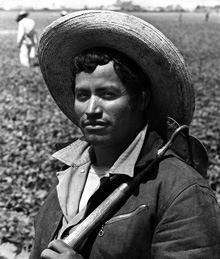
|  |  |  News Around the Republic of Mexico | October 2008 News Around the Republic of Mexico | October 2008  
Mexican Ministry Satisfied with Braceros Agreement
 Sophia Tareen - Associated Press Sophia Tareen - Associated Press
go to original


| | The Bracero program (1942 through 1964) allowed Mexican nationals to take temporary agricultural work in the United States. Over the program’s 22-year life, more than 4.5 million Mexican nationals were legally contracted for work in the United States. (Leonard Nadel) | | |
Mexico's Foreign Affairs Ministry said this week that it is satisfied with a multimillion dollar settlement allowing Mexican laborers who were part of a World War II-era visitor working program in the U.S. to collect money that had been withheld from their paychecks.

The preliminary settlement approved by a federal judge last week in San Francisco “represents a mutually beneficial solution,” the Ministry said in a statement.

“The Government of Mexico trusts that this agreement will close a long controversy and that former migratory workers ... or their successors residing in the US will find a final solution,” the statement said.

A Chicago-based attorney filed a lawsuit seeking class-action status on behalf of several laborers, or braceros, who claim they were unfairly denied wages while working in agriculture and the railroads from 1942 to 1946.

An estimated 2.5 million braceros worked in the U.S. between 1942 and 1964. The first group of workers had about 10 percent of their paychecks withheld and sent to the Mexican government.

In 2005, the Congress of Mexico approved a $26.5 million fund to pay braceros the rest of their wages. But the government required braceros or the families of deceased workers to file their claims at offices in Mexican state capitals or Mexico City.

Under the terms of last week's preliminary agreement, which does not admit fault, the Mexican government agreed to pay about $14.5 million to braceros in the U.S.

Each person is eligible for up to $3,500. The deal is subject to final approval in February.

“It's enough money to be meaningful (to those) who are mostly men of moderate means,” said Chicago attorney Matthew Piers. “It's the significance of a recognition that they were treated in this manner.”

Those who worked from 1942 to 1946 in the U.S., or surviving family members, can apply for claims starting next week. Former braceros must present original paperwork and proper identification. They must reside in the U.S. but do not have to be citizens.

It is unknown how many braceros are still alive and could be eligible.

But several have already stepped forward in California and Illinois, including Jesus Ruiz, a 92-year-old Chicago man who is the father of Jesse Ruiz, chairman of the Illinois State Board of Education. |

 |
|  |



